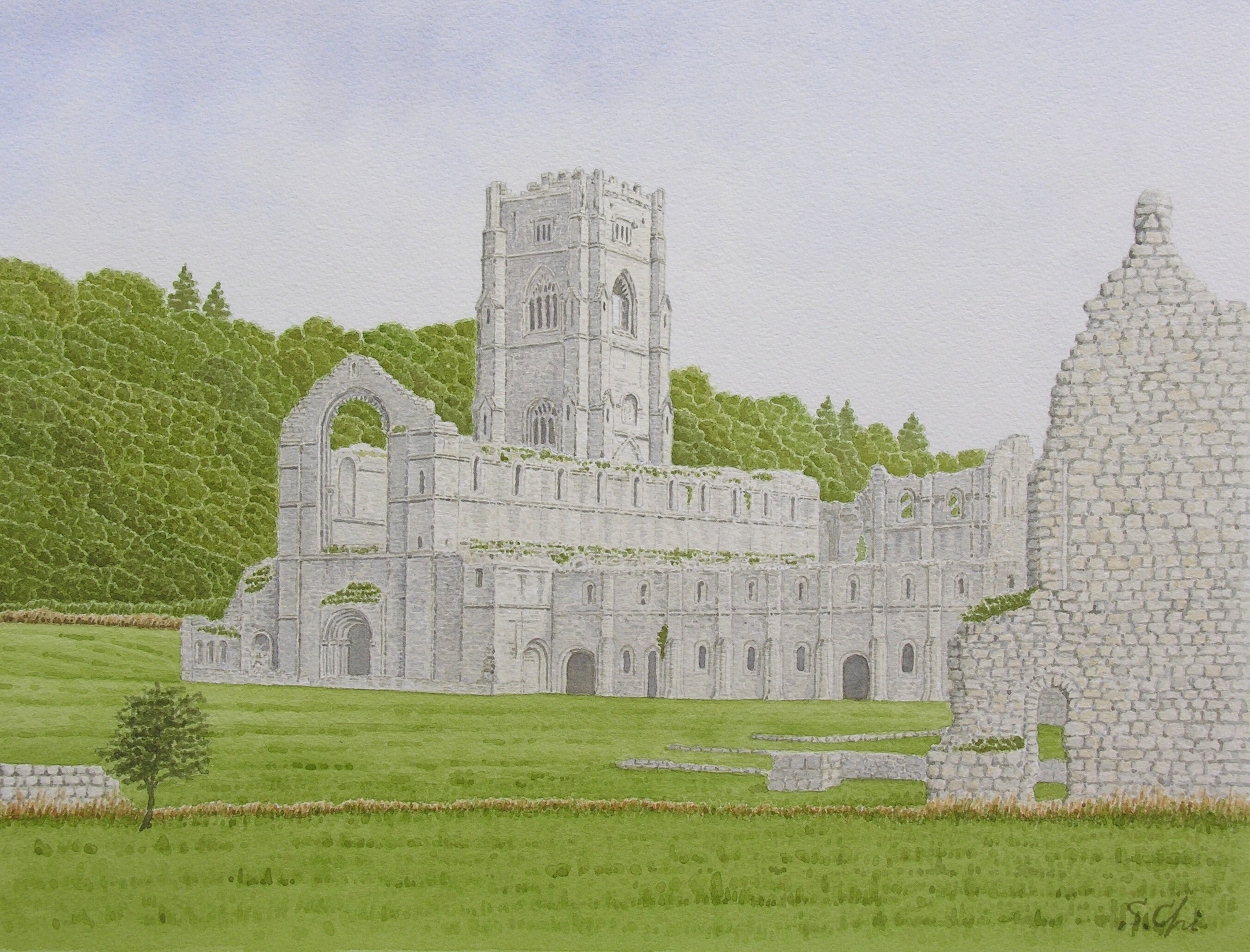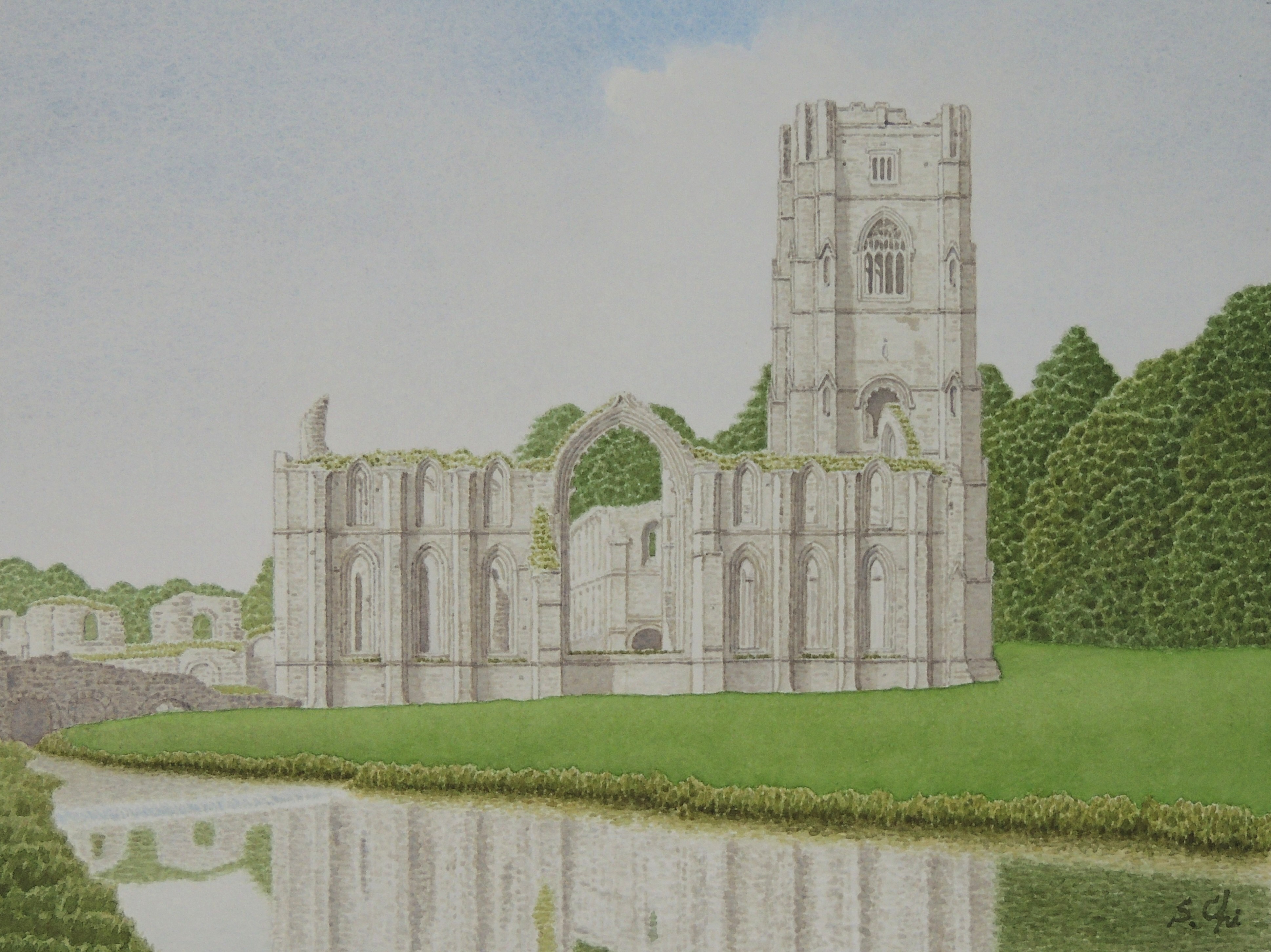
遙かなる わがヨークシャー (Faraway My Yorkshire)
リーズ周辺 (Leeds' Environs)
28 ファウンテンズ修道院 [リポン] (Fountains Abbey, Ripon)

リップリー・カースルからA61号線をさらに北へとむかう。5kmほど行ったところで左折して、畑のなかの田舎道をゆく。しばらくすると、森のなかのスケル川のほとりに、ファウンテンズ修道院の壮大な廃墟が見えてくる。
廃墟に近づくと、まずその大きさに圧倒される。ただ息を呑んでは、しばし佇むばかりである。
この廃墟は、イギリスはもとよりヨーロッパでも、もっとも大きくもっとも美しい廃墟の一つとされている。その美しさは、説明を要さない。
つぎに、これだけの大伽藍がいっときにして廃墟となっていったことに驚く。それももとをただせば、ヘンリー8世というひとりの男の都合によってである。はたしてこれは歴史の必然だったのか、それとも気まぐれだったのだろうか。
ファウンテンズ修道院は、シスターシャン修道会のなかでも中心的な存在だったところである。1132年に建設がはじまり、13世紀のなかごろまでに聖堂のおもな部分ができていたとされる。その後も増築と改造がくりかえされ、16世紀の初めまで営々と肥大化の一途をたどり、修道会のなかで最大規模を誇ってきた。
廃墟の広さは、およそ4haもある。
聖堂*を建築様式的に見れば、大部分がノルマン様式で、13世紀前半に建てられた内陣、つまり聖堂の東側の部分が、ゴシック様式のなかでも初期イギリス様式*というものになっている。
この修道院は、13世紀に繁栄の絶頂期をむかえ、ヨークシャーの丘陵地帯の3分の2、約40万haの土地を所有していたとされる。そして羊の放牧地でもっとも遠いところは、西へおよそ48kmも離れたところにあったが、そこへ行くのに、修道院の敷地から外れることがなかったという。
ファウンテンズ修道院の羊毛の生産量はイングランド北部一を誇り、大陸にまで輸出していた。また、ペナイン山中のニダーデイルでは鉄鉱石を採掘し、製鉄をおこない、農機具などの製品も作っていた。北海沿岸では漁業もおこない、水揚げしたものをスカーバラの市で商っていたという。まさに、多角経営の一大企業である。
ファウンテンズ修道院は、たしかに壮大な修道院であったことは分かるが、何かそこに、清貧を信条とした信仰生活とはそぐわないものが感じられる。
歴史家G.M.トレヴェリアンは『イギリス史』(大野真弓監訳、みすず書房)のなかで、「この修道会が名うての強欲のために同時代人から徹底的に罵られていた」と指摘している。
シスターシャンは、封建領主から寄進された土地に住人がいると、彼らをそこから追い出すこともあったという。
世の古今東西を問わず、宗教団体が巨大になるとしばしば傲慢になるものであるが、シスターシャン修道会の場合には、その変質した性格に原因があった。
この修道会は、大陸ではシト―修道会と呼ばれたが、1098年にフランスでベネディクト修道会から派生したものである。それまでの修行にあきたらず、よりきびしい修行をもとめた修道士たちが興したもので、イギリスには12世紀になってから入ってきた。
そしてほかの修道会(ベネディクト修道会やアウグスト修道会ほか)が比較的、町や村に近いところに修道院を建てたのにたいして、シスターシャンは人里離れたより辺鄙なところに修道院を建てた。そして世俗とは隔絶した、より禁欲的できびしい修行生活をおくっていた。その点、イングランド北部の荒涼とした丘陵地帯は、シスターシャンにとっては理想の地であった。
しかしこの修道会も、牧羊をはじめとする農業やそのほかの経済活動で潤って勢力を拡大してゆくと、本来の信条をすっかり忘れ、その性格も傲慢なものに変質してしまったのである。
15世紀末から16世紀の初めにかけて、ファウンテンズ修道院の北翼廊には、高さが約49mもある巨大な「ハビーの塔」が建てられた。この修道院の歴史でもっとも偉大とされる当時の院長マーマデューク・ハビーの名前をとって名づけられた塔である。
わたしの上の水彩画は廃墟を南西側から見たところを描いたものであるが、画面中央の奥にそびえているのが「ハビーの塔」である。この塔は、かつてのこの修道院の繁栄ぶりを象徴するものである。
ところば初期のシスターシャンの修道院では、「力を誇示するような塔は修道院にはふさわしくない」と、その建設が禁止されていたという。しかしそれも、繁栄の極みにあったファウンテンズ修道院には、もはや通用するものではなかったのだろう。
中世には、イングランドとウェールズに1千カ所以上の修道院の施設があったとされる。しかしそのほとんどが、ヘンリー8世の修道院解散*によって、1536年から1539年のあいだに姿を消していった。
イングランドでもっとも富めると言われたこのファウンテンズ修道院も1539年に解散し、400年にわたるその歴史を閉じた。そして廃墟となり、森のなかに埋もれていった。
修道院の廃墟は、ふだんは訪れる人も少なく、ひっそりとした静かな空間である。それにしてもヘンリー8世は、思い切ったことをしたものである。

ファウンテンズ修道院の東正面 (East Front of Fountains Abbey)
<New Work for Website>
As I was driving along the A61 from Ripley Castle towards Ripon and turning
left on the way and going along a country road that continued in the fields,
the ruins of Fountains Abbey came into sight in the woods on the River
Skell.
Approaching the ruins, I was surprised at the breathtaking magnificent
view and the scale of the abbey at first. And I stood still for a while.
The beauty of the ruins of this abbey needs no explantion. I heard it is
the biggest and the most beautiful ruins in England , even in Europe. I
agree with this remark.
Then I was surprised again to know this great abbey was ruined suddenly by the action of one man, Henry VIII. It was the neccessity of history, or some quirk of it, I wonder.
Fountains Abbey was founded here by the Cistercians in 1132 and completed
almost in the mid 13th century. But the abbey continued enlarging afterwards;
the extension and remodelling repeated by the early 16th century.
The ruins spread about 10 acres. Almost all of the abbey constructions were built in the Norman style, except for the presbyterry, the eastern part of the church, which was made in the Early English style.
The prosperity of the abbey reached its peak in the 13th century, and it
is said that Fountains Abbey became the biggest landlord in Yorkshire,
prossessing about a million acres, two thirds of Yorkshire dales. It is
amazing that it was possible to travel nearly 30 miles westwards from the
abbey without leaving its property.
Fountains Abbey had produced the greatest quantity of wool in northern
England and had exported some of it even to the continent. Becoming a huge
enterprise, Fountains Abbey also mined iron ore in Nidderdale and smelted
it in a smithy of the abbey. Further, the abbey did inshore fishing in
the North Sea and sold the catch in the fish market of Scarborough.
Fountains Abbey was a great religious house, and I can imagine the magnificence
of it in its glorious days. I cannot but feel something beyond or unsuitable
for the religious life and creeds of apostolic poverty. Also, it is ironical
that G. M. Trevelyan, a great historian, referred in his "History
of England" to the effect that this monastery was abuused thoroughly
for its notorious greed for economic activities by contemporaries.
It is true that any part of the world and anytime of the history, huge
religious orders have a tendency to become arrogant.
Huby's Tower, rising more than 160 feet, was built by Abbot Marmaduke Huby
in possibly from the end of the 15th century to the early 16th century.
In the early Cistercians, the building of the tower was forbidden. The
reason might be the proudly tower was not suitable for religious houses,
I suppose. But the wealthy Fountains Abbey got rid of the habit.
Having been the symbol of the final glory of the abbey, the tower still
symbolizes the old day's prosperity of this abbey.
Fountains Abbey, the richest abbey in England, was also dissolved in 1539,
closing its 400 years' history, and it was left ruined in the woods.
There were more than 1,000 monasteries in England and Wales in the Middle Ages. But almost all the abbeys and priories disappeared under the Dissolutions of the Monasteries of Henry VIII between 1536 and 1539. What a great king he was!
*聖堂 →第3節の脚注
*初期イギリス様式 (Early English) イギリスで12世紀の終わり頃から13世紀の終わり頃まで盛んに使われたゴシック様式。厚い壁、ランセット形窓(先の尖った高くて細長い窓)、ケトゥラフォイルという四葉模様をほどこしたトレイサリー(窓上部の狭間飾り)などの重厚な造りが特徴。
*修道院解散→第1節の脚注